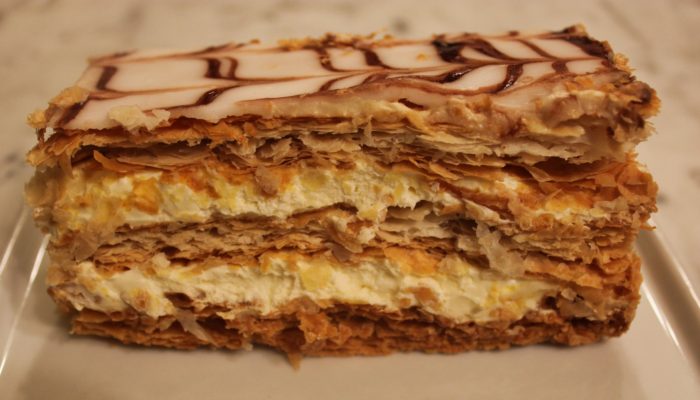
Oh, I don’t eat these for the puff pastry. It’s the pastry cream. Just that pastry cream.
I’m updating this post from one four years ago by adding two more recipes and showing you how diverse the recipes for pastry cream can be.
If you were a mathematician, a statistician actually, then your life would be based on comparing things. How are they different? Which is the best? Is there a best?
You would be surprised what can be compared. For example, what could be a more basic component of a great dessert than pastry cream? Ladled into a pastry shell, adored with fruit or chocolate, pastry cream is that basic building block we all depend on.
Just how basic? I’ve compared pastry cream recipes from three outstanding books:
- Pastry by Michel Roux
- Southern Italian Desserts by Rosetta Costantino
- Patisserie: Mastering the Fundamentals of French Pastry by Christophe Felder
- Patisserie Made Simple by Edd Kimber
- French Pâtiserrie from Ferrandi
Pastry by Michel Roux is Suzen’s standby pastry book. We’ve made many of the recipes, love the crust options and indulge now and then on its great pastry cream. It’s Paris.
Southern Italian Desserts is a meticulously researched book that features the authentic styles of Southern Italy. These are recipes honed by endless generations of home cooks.
And Patisserie is a most beautiful and astonishing comprehensive treasure chest of French pastry arts. The book is illustrated with 3200 color photos for step by step assistance in each of the recipes in this ultimate encyclopedia.
Patisserie Made Simple is from a Brit with a French pastry obsession. He won a season of The Great British Bake Off so his skills are impeccable.
French Pâtiserrie comes from prestigious Ferrandi cooking school in Paris. This new book, I’m sure the heaviest one I have ever lifted, is the new go-to encyclopedia for French pastries.
In comparing the five recipes for basic pastry cream in these books, I expected to find minor shifts in ingredients or their proportions. And modest suggested alternatives for techniques. I mean, its pastry cream. It can’t be that different.
Oh, it can. Here is a comparison of the ingredients for around 2 cups of pasty cream:
| Ingredient | Pastry | Southern | Patisserie | Simple | Ferrandi |
| Egg, Yolks | 6 | 3 | 6 | 6 | |
| Eggs, Whole | 2 | 2 | |||
| Sugar | ½ cup + 2 T | ½ cup + 1 T | ⅔ cup | 1 [superfine] | ½ |
| Flour | ¼ cup | 2 T | |||
| Milk | 2 cups | 2 cups | 2 ½ | 2 cups | |
| Half‑and‑half | 1 ½ cups | ||||
| Butter | 3 T | 3 T | |||
| Vanilla bean | 1 | 1 | 1 | 1 | |
| Lemon peel | 1 small lemon | ||||
| Cornstarch | 3 T | 3 T | ½ cup | 2 T |
This comparison demonstrates that there is “no simple thing.” The contrasts are major. For example, Pastry and Patisserie use the same amount of eggs — and twice those of Southern but one uses flour and the other cornstarch. Perhaps you would not notice the flour-versus-cornstarch difference in your mouth but there are many, I assure you, who would prefer one to another.
The new Ferrandi is quite distinctive. Two whole eggs are employed, no “egg yolks only” here. And this recipe is the only one to use both flour and cornstarch.
Which is best? Oh, don’t even think of going there. Each of these recipes stands on its own, including its own set of ingredients. All are certain to be really, totally addictive. The real question is which do you prefer. Is your flavoring preference for vanilla or lemon? Does milk create the best texture for you, or milk plus butter, or half‑and‑half? Your preference will be determined by your food history, literally what your mother made. And by the mouth feel you desire, the way the cream reacts as you bite, and of course how the pastry cream mates with other flavors in your dish. That lemon flavor may be ideal for a berry tart, but vanilla may be better for chocolate.
The next time your recipe calls for pastry cream, take a moment, pause, and maybe do a little research. Or, and this is better, make two pies. With a different pastry cream in each one. Let your spouse taste test, evaluate, and marvel at your skills.
At least that’s what I wish my wife Suzen would do.
